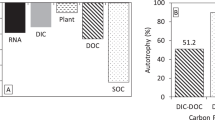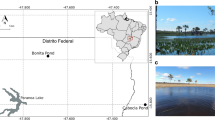Abstract
Past studies of microbial communities responsible for geochemical transformations have been limited by an inability to representatively cultivate, and then identify, the constituent members. Ribosomal RNA sequences, particularly 16S-like rRNAs, provide a measure of phylogenetic relationship that can now be used to examine the structure and diversity of microbial communities. Sulfate-reducing bacteria (SRB) play an important role in the sulfur cycle and the terminal mineralization of organic matter in estuarine and marine environments. Because the Gram-negative mesophilic SRB comprise a phylogenetically coherent assemblage, their communities are well suited to explorations through rRNA sequence-based methodologies. In this study we related molecular biological methods using rRNA probes to geochemical measurements at two different sites. At an unvegetated site in northwest Florida, rates of sulfate reduction were low and SRB rRNA comprised about 5% of the total rRNA extracted from the sediment. The other site, a salt marsh in New Hampshire, had higher rates of sulfate-reduction with SRB rRNA accounting for up to 30% of the total rRNA extracted from the sediment. SRB community structure differed dramatically between the two sites with Desulfobulbus rRNA much less abundant in the unvegetated site than in the salt marsh. The differences in these SRB communities reflect differences in the ecology of their habitats.
Similar content being viewed by others
References
Amann RI, Stromley J, Devereux R, Key R, Stahl DA (1992) Molecular and microscopic identification of sulfate-reducing bacteria in multispecies biofilms. Appl Environ Microbiol 58:614–623
Amann RI, Ludwig W Schleifer K-H (1995) Phylogenetic identification and in situ detection of individual microbial cells without cultivation. Microbiol Rev 59:143–169
DeLong EF, Frankel RB, Bazylinski DA (1993) Multiple evolutionary origins of magnetotaxis in bacteria. Science 259:803–806
Devereux R, Mundfrom GM (1994) A phylogenetic tree of 16S rRNA sequences from sulfate-reducing bacteria in a sandy marine sediment. Appl Environ Microbiol 60:3437–3439
Devereux R, Stahl DA (1993) Phylogeny of sulfate-reducing bacteria and a perspective for analyzing their natural communities. In: Odom JM, Singleton R Jr (eds) Sulfate-reducing bacteria: contemporary perspectives. Springer-Verlag, New York, pp 131–160
Devereux R, Delaney M, Widdel F, Stahl DA (1989) Natural relationships among sulfate-reducing bacteria. J Bacteriol 171:6689–6695
Devereux R, Kane MD, Winfrey J, Stahl DA (1992) Genus- and group-specific hybridization probes for determinative and environmental studies of sulfate-reducing bacteria. J Syst Appl Microbiol 15:601–609
Farrelly V, Rainey FA, Stackebrandt E (1995) Effect of genome size and rrn gene copy number on PCR amplification of 16S rRNA genes from a mixture of bacterial species. Appl Environ Microbiol 61:2798–2801
Hines ME, Knollmeyer, Tugel JB (1989) Sulfate reduction and other sedimentary biogeochemistry in a northern New England salt marsh. Limnol Oceanogr 34:578–590
Hines ME, Banta GT, Giblin AE, Hobbie JE, Tugel JT (1994) Acetate concentrations and oxidation in salt marsh sediments. Limnol Occanogr 39:140–148
Howarth RW, Jørgensen BB (1984) Formation of 35S-labelled elemental sulfur and pyrite in coastal marine sediments (Limfjorden and Kysing Fjord, Denmark) during short-term 35SO4 2− reduction measurements. Geochim Cosmochim Acta 48:1807–1818
Kane MD, Poulsen LK, Stahl DA (1993) Monitoring the enrichment and isolation of sulfate-reducing bacteria by using oligonucleofde hybridization probes designed from environmentally derived 16S rRNA sequences. Appl Environ Microbiol 59:682–686
Laanbroek HJ, Abee T, Voogd IL (1982) Alcohol conversion by Desulfobulbus propionicus strain Lindhorst in the presence and absence of sulfate and hydrogen. Arch Microbiol 133:178–184
Larsen N, Olsen GJ, Maidak BL, McCaughey MJ, Overbeek R, Macke TJ, Marsh TL, Woese CR (1993) The ribosomal database project. Nucleic Acids Res 21:3021–3023
Lovley DR, Phillips EJP (1994) Novel processes for anaerobic sulfate production from elemental sulfur by sulfate-reducing bacteria. Appl Environ Microbiol 60:2394–2399
Mendelssohn IA, McKee KL, Patrick JWH (1981) Oxygen deficiency in Spartina altemiflora roots: metabolic adaptation to anoxia. Science 214:439–441
Moran MA, Torsvik VL, Torsvik T, Hodson RE (1993) Direct extraction and purification of rRNA for ecological studies. Appl Environ Microbiol 59:915–918
Pace NR, Stahl DA, Lane DJ, Olsen GJ (1986) The use of rRNA sequences to characterize natural microbial populations. Adv Microbial Ecol 9:1–55
Parkes RJ, Cragg BA, Bale SJ, Getliff JM, Goodman K, Rochelle PA, Fry JC, Weightman AJ, Harvey SM (1994) Deep bacterial biosphere in Pacific Ocean sediments. Nature (London) 371:410–413
Poulsen LK, Ballard G, Stahl DA (1993) Use of rRNA fluorescence in situ hybridization for measuring the activity of single cells in young and established biofilms. Appl Environ Microbiol 59:1354–1360
Ramsing NB, Kühl M, Jørgensen BB (1993) Distribution of sulfate-reducing bacteria, O2, and H2S in photosynthetic biofilms determined by oligonucleotide probes and microelectrodes. Appl Environ Microbiol 59:3840–3849
Risatti JB, Capman WC, Stahl DA (1994) Community structure of a microbial mat: the phylogenetic dimension. Proc Natl Acad Sci (USA) 91:10173–10177
Stahl DA, Amann R (1991) Development and application of nucleic acid probes. In: Stackebrandt E, Goodfellow M (eds) Sequencing and hybridization techniques in bacterial systematics. J Wiley & Sons, Chichester, England, pp 205–248
Stahl DA, Flesher B, Mansfield HR, Montgomery L (1988) Use of phylogenetically-based hybridization probes for studies of ruminal microbial ecology. Appl Environ Microbiol 54:1079–1084
Willis SG, Sharak Genthner BR, Friedman S, Hines ME, Devereux R (1995) Digestion of 16S rDNA PCR products with restriction endonucleases recognizing 4-bp sequences provides a method for rapid phylogenetic assignment of bacteria from anaerobic enrichment cultures. Abstr Gen Meeting Am Soc Microbiol Q149:425
Woese CR (1987) Bacterial Evolution. Microbiol Rev 51:221–271
Author information
Authors and Affiliations
Additional information
Contribution No. 917 from the Gulf Ecology Division, NHEERL, Gulf Breeze, FL.
Correspondence to: R. Devereux.
Rights and permissions
About this article
Cite this article
Devereux, R., Hines, M.E. & Stahl, D.A. S cycling: Characterization of natural communities of sulfate-reducing bacteria by 165 rRNA sequence comparisons. Microb Ecol 32, 283–292 (1996). https://doi.org/10.1007/BF00183063
Received:
Accepted:
Issue Date:
DOI: https://doi.org/10.1007/BF00183063




